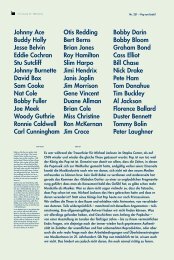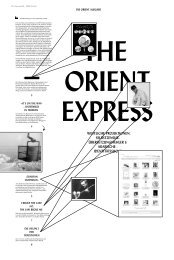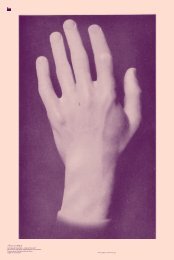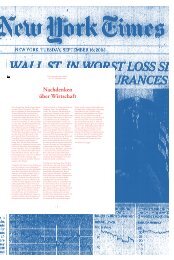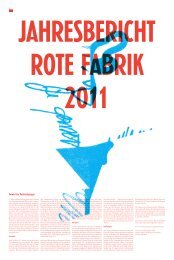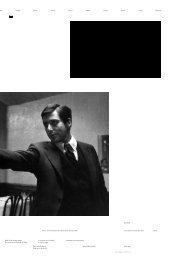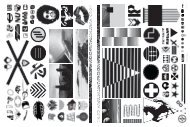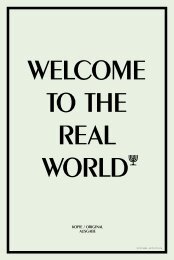Art of Destruction — Fabrikzeitung Nr. 277, Dezember ... - Rote Fabrik
Art of Destruction — Fabrikzeitung Nr. 277, Dezember ... - Rote Fabrik
Art of Destruction — Fabrikzeitung Nr. 277, Dezember ... - Rote Fabrik
Sie wollen auch ein ePaper? Erhöhen Sie die Reichweite Ihrer Titel.
YUMPU macht aus Druck-PDFs automatisch weboptimierte ePaper, die Google liebt.
Erasure in <strong>Art</strong>: From<br />
<strong>Destruction</strong> to Palimpsest<br />
In 1953 Robert Rauschenberg produced a work entitled «Erased de<br />
Kooning Drawing». The work was made using erasers to literally rub out<br />
a drawing that Rauschenberg had persuaded Willem de Kooning to<br />
give him, specifically for the purpose <strong>of</strong> erasing it. The work apparently<br />
took a month and about forty erasers to erase/make. Calvin Tomkins<br />
reacts to the destructive element in the work: «What else, in God’s name,<br />
could you think about his wanting to erase a de Kooning drawing?<br />
The implications were so blatantly Freudian, the act itself so obviously<br />
symbolic (if good natured) patricide.»<br />
Rauschenberg recognised this element <strong>of</strong> eradication when he<br />
later talked <strong>of</strong> trying «to purge myself <strong>of</strong> my teaching». The word «purge»<br />
here indicating a cleaning and purifying process, rather than a violent<br />
destruction. Rauschenberg stresses that the main aim <strong>of</strong> this work was<br />
to find out «whether a drawing could be made out <strong>of</strong> erasing» and the<br />
painter Jasper Johns referred to the Erased de Kooning as «additive sub-<br />
traction». Is it conceivable therefore that any form <strong>of</strong> erasure, however<br />
apparently destructive, can be seen as constructive in some way?<br />
John Latham was one <strong>of</strong> several artists who participated in the<br />
two international gatherings called <strong>Destruction</strong> in <strong>Art</strong> Symposium<br />
(DIAS), held in London in 1966 and New York in 1968. Latham burnt<br />
stacks <strong>of</strong> books that he called «Skoob Towers» (the word Skoob<br />
coming from the reversal <strong>of</strong> the letters in the word books). Contradictions<br />
arise in the surrounding literature: John A. Walker states that<br />
Latham was «critical <strong>of</strong> language as a medium <strong>of</strong> communication and <strong>of</strong><br />
books as reservoirs <strong>of</strong> received knowledge», although Latham himself<br />
states that «It was not in any degree a gesture <strong>of</strong> contempt for books or<br />
literature. What it did intend was to put the proposition into mind that<br />
perhaps the cultural base had been burnt out»<br />
However something emerges from the destruction. Brooks and<br />
Stezaker point out the Nietzschian element <strong>of</strong> Latham’s book burnings:<br />
«An acceleration <strong>of</strong> the innate self-destructive tendencies <strong>of</strong> culture, so<br />
that (quite literally) a new culture might emerge, phoenix-like, from the<br />
ashes <strong>of</strong> the old.» This idea, which can be traced to the nineteenth cen-<br />
tury anarchist Mikhail Bakunin, would suggest that any erasure <strong>of</strong> text,<br />
however violently destructive, carried within it the preparation for<br />
renewal.<br />
In the 1960ies, Ad Reinhardt reduced his paintings to a flat<br />
black canvas, which he described as «the last painting which anyone<br />
can make». The artist Joseph Kosuth wrote <strong>of</strong> Ad Reinhardt’s work:<br />
«Painting itself had to be erased, eclipsed, painted out in order to make<br />
art.» There is, in this, a certain completion, an arrival at some quintessential<br />
essence <strong>of</strong> modernism. However, Reinhardt himself stressed<br />
the negation <strong>of</strong> this act: «The painting, which is a negative thing, is the<br />
statement, and the words I’ve used about it have all been negative<br />
statements to keep the painting free.»<br />
«Reinhardt resisted laying values on the work because the<br />
negation had to be absolute. The black paintings <strong>of</strong>fered a clean slate<br />
for painting and prepared the ground for a new departure. However,<br />
inescapably, the black painting’s lack <strong>of</strong> style becomes a style in itself.<br />
The negation takes its form from an erasure <strong>of</strong> a particular set <strong>of</strong><br />
positive values. In this way acts <strong>of</strong> erasure can be seen as part <strong>of</strong> the<br />
circular/linear development <strong>of</strong> a form, with any consequent new de-<br />
parture taking its form from a rejection <strong>of</strong> the erased subject. The ruling<br />
subject is overturned, but lives on through its inversion.<br />
Writing ‘sous rature’ (under erasure) is a technique that Jacques<br />
Derrida employed in his philosophical writings. By crossing out or<br />
striking through words, but still printing the words in their crossed-out<br />
state, Derrida implied that something was «inaccurate yet necessary to<br />
say». Spivak makes the most comprehensive study <strong>of</strong> erasure in her<br />
«Der destruktive Charakter ist jung und heiter. Denn Zerstören<br />
verjüngt, …» Walter Benjamin, «Der destruktive Charakter»<br />
Prometheus, der Schöpfer der Menschen und Tiere, hat auch das Feuer<br />
gebracht, und damit die Zerstörung. Seine Gestalt erinnert an die<br />
ursprüngliche Dialektik von Produktion und Destruktion, die sich in der<br />
Moderne vollends entfaltet, politisch und ästhetisch.<br />
Als Figur einer explizit modern begriffenen Ästhetik wie ästhe-<br />
tisch begriffenen Moderne gehören die Destruktion und das Destruktive<br />
zu den Prozesskategorien des Werdens, sind positiv und progressiv –<br />
im wörtlichen Sinne des Lateinischen «destruere» als «Abstapeln», oder<br />
besser noch: «Abschichten». Und erst mit der destruktiven Tendenz<br />
der Moderne selbst verschiebt sich die Bedeutung des Destruktiven<br />
ästhetisch (ebenso wie politisch) ins Negative, Negatorische und Ne-<br />
gierende, kurzum: wird die Destruktion zum Synonym mit Zerstörung<br />
und schließlich Vernichtung.<br />
Gleichwohl konfrontiert eine Ästhetik der Destruktion und de-<br />
struktive Ästhetik allerdings die reale Gewalt von Vernichtung, die die<br />
Moderne selbst zeitigt, und gerät damit zum dialektischen Prinzip einer<br />
Negation der Negation: die Strategien der Zerstörung, die in der Kunst<br />
ihren Ausdruck finden, gehören mithin zu den ästhetischen Aufhebungs-<br />
Bewegungen, ja Aufhebungs-Methoden (wobei auch hier buchstäb-<br />
lich übersetzt werden darf, wie Walter Benjamin vorschlägt: «Methode<br />
ist Umweg»).<br />
Und gerade in der Musik, vor allem dann im weiten Feld des<br />
Pop, sind solche Methoden einer Ästhetik der Destruktion und dest-<br />
ruktive Ästhetik virulent. Hier zeigt sich im Übrigen dann auch, hörbar<br />
seit den ersten Rückkopplungspfeifen und Verzerrungsschleifen, die<br />
Kongruenz der Destruktion zur Konstruktion. (Und die poststrukturalistische<br />
Literaturtheorie hat daraus ihr methodisches Programm der<br />
Dekonstruktion formuliert – eben zu der Zeit, wo Jimi Hendrix live at<br />
Berkeley seine Gitarre anzündete, wo er in Woodstock das Star-<br />
Spangled Banner im simulierten Maschinengewitter zertrümmerte, wo<br />
Keith Emerson zu Leonard Bernsteins «America» aus der «West Side<br />
Story» seine Hammond-Orgel mit Messer und Säbel malträtierte und<br />
die Hallspirale knallen ließ, und eben zu der Zeit von My Lai und<br />
Martin Luther King, Militärdiktatur und Kulturrevolution; die Zeit vom<br />
Mai Achtundsechzig.<br />
Abgesehen davon, dass ohnehin seit jeher Musik auch von der<br />
dynamisch-dionysischen Erhabenheit der Klanggewalt lebt (im Rausch<br />
des Glockenschlags oder im bacchantischen Tänzen), ist diese Ästhetik<br />
der Destruktion und destruktive Ästhetik in der Musik schon in den An-<br />
fängen ihrer neuzeitlichen Formensprache angelegt: Jede Oper imp-<br />
liziert Destruktives, arbeitet sich am Tod ab.<br />
Mit der Herausbildung der philosophischen Ästhetik<br />
(Baumgarten, Burke, Shaftesbury, schließlich Kant und Schiller, zweite<br />
Hälfte 18. Jhd.) bekommt die Destruktion ihre begriffliche Form. Mit<br />
dem Kunstwerk wird die Produktionsästhetik – die Ästhetik der Pro-<br />
duktion ebenso wie die Ästhetik des Produktiven – zugleich auch zur<br />
introduction to Derrida’s Of Grammatology. She says «..the authority <strong>of</strong><br />
the text is provisional…we must learn to use and erase our language at<br />
the same time.» Derrida says «At each step I was obliged to proceed<br />
by ellipses, corrections and corrections <strong>of</strong> corrections, letting go <strong>of</strong> each<br />
concept at the very moment that I needed to use it». In this philosophical<br />
context erasure becomes a term and a strategy associated with the<br />
wider project <strong>of</strong> Deconstruction. Often words are not actually printed<br />
with erasing lines, but are still described as being «under erasure» with<br />
the same implication that the term is «inaccurate and yet necessary<br />
to say».<br />
A similar use <strong>of</strong> crossed-out words can be seen in Joseph<br />
Kosuth’s artworks «Zero and Not», 1986, and «Zero and Not», 1989.<br />
In these large installations the walls are lined with wallpaper carry-<br />
ing text from Freud’s writings struck through with strong black lines.<br />
So does Kosuth’s erasure constitute a negative critique <strong>of</strong> Freud’s<br />
theories? Conversely Nancy Princenthal’s reading suggests a certain<br />
grudging affirmation <strong>of</strong> Freud’s theories: «The installation is an ironic<br />
confirmation <strong>of</strong> a fundamental psychoanalytic dictum, or at least a<br />
mocking concession to it: you can repress Freudian theory but that<br />
wont make it go away... Kosuth demonstrates that the harder one tries<br />
to obliterate Freud’s claims, the more forcefully, if deviously, they try<br />
to assert themselves.»<br />
Other ambiguous erasures in art can be found. In the silk-<br />
screen print «Untitled (Skull)» from the portfolio «Reality and Paradoxes»,<br />
1973, Jasper Johns crosses out his own signature. Fred Orton<br />
writes: «He seems to be writing that it’s necessary but inaccurate to<br />
say that this was made by Jasper Johns. He seems to be guaranteeing<br />
the text by signing it and then drawing attention to the problematic<br />
nature <strong>of</strong> authorship and ownership by crossing out the signing, clearly<br />
opening to doubt its power to confer authenticity, but not denying it.»<br />
In an interview Johns discusses his reasons for crossing out part <strong>of</strong> a<br />
different painting «Bent ‘Blue’ (Second State)», 1971. Johns says: «In a<br />
sense it is to say it is <strong>of</strong> no importance, because in Bent ‘Blue’, that area<br />
is constantly changing, so it’s not too important what’s there. But ob-<br />
viously it’s <strong>of</strong> great importance what’s there because that is what’s there.<br />
But it could be anything else - that or the next image.»<br />
This is not the way in which erasure is usually understood. As<br />
Robert C. Morgan says <strong>of</strong> Kosuth’s work: «The covering <strong>of</strong> language<br />
carries with it the suggestion that what is present beneath is significant<br />
in view <strong>of</strong> its absence.» Surely John’s crossing out <strong>of</strong> part <strong>of</strong> his picture<br />
draws our attention to it, creating an area <strong>of</strong> heightened significance?<br />
However Fred Orton reinforces John’s assertion: «As an ‘undecidable’<br />
that crossed out bit <strong>of</strong> the surface is neither insignificant nor significant,<br />
neither less important nor more important, neither inadequate nor<br />
adequate, neither wrong nor right, neither unwanted nor wanted.» This<br />
is erasure as a gesture <strong>of</strong> some uncertainty.<br />
The word palimpsest is defined by the Concise Oxford Dict-<br />
ionary, 1976 as: «writing material or manuscript on which the original<br />
writing has been effaced to make room for a second writing». It should<br />
be noted that there are three stages to this process - the initial writing,<br />
the erasure, and then the rewriting. However, in general usage the term<br />
is most <strong>of</strong>ten applied metaphorically in cases where the new writing is<br />
directly over the top <strong>of</strong> the old text. The new writing creates the erasure<br />
<strong>of</strong> the old. This can be seen in Roland Barthes’s usage <strong>of</strong> the word,<br />
writing here in relation to the paintings <strong>of</strong> Cy Twombly: «The hand has<br />
drawn something like a flower and then has begun “dawdling” over<br />
this line; the flower has been written, then unwritten; but the two mo-<br />
vements remain vaguely superimposed; it is a perverse palimpsest..»<br />
Barthes describes Twombly as a «painter <strong>of</strong> writing» and discusses the<br />
12<br />
application <strong>of</strong> marks onto a dirtied surface in terms <strong>of</strong> graffiti: «...what<br />
constitutes graffiti is in fact neither the inscription nor its message<br />
but the wall, the background, the surface (the desktop); it is because<br />
the background exists fully as an object that has already lived, that such<br />
writing always comes as an enigmatic surplus... that is what disturbs<br />
the order <strong>of</strong> things; or again: it is ins<strong>of</strong>ar as the background is not clean<br />
that it is unsuitable to thought (contrary to the philosopher’s blank<br />
sheet <strong>of</strong> paper)...»<br />
If we interpret erasure as graffiti in these terms, the erasure<br />
could be seen as an attempt to re-clean the background, to move it<br />
towards the blank sheet which is more «suitable for thought». (However,<br />
as already discussed, the thought that it prepares the way for is inevit-<br />
ably polluted by the traces <strong>of</strong> the background that is never successfully<br />
cleaned – if the erasure moves the background, the text, into a state<br />
which is more suitable to thought, this is only thought in relation to<br />
itself). But the erasure itself could also be considered as the rewriting.<br />
The marks <strong>of</strong> erasure are the ‘enigmatic surplus’ to the original text.<br />
In Neville Wakefield’s writing about Ann Hamilton’s «Tropos», 1993, a<br />
performance involving the methodical burning out <strong>of</strong> lines <strong>of</strong> text<br />
from a book, the erasure itself creates a palimpsest: «...as each line is<br />
read it is singed out <strong>of</strong> existence with a small heated implement,<br />
language and text disappearing in a thin arabesque <strong>of</strong> smoke - the de-<br />
licate imprint <strong>of</strong> the erased text, a palimpsest <strong>of</strong> language and the<br />
body.» The palimpsest introduces the idea <strong>of</strong> erasure as part <strong>of</strong> a lay-<br />
ering process. There can be a fluid relationship between these layers.<br />
Texts and erasures are superimposed to bring about other texts or era-<br />
sures. A new erasure creates text; a new text creates erasure.<br />
Barthes’ use <strong>of</strong> the words «perverse palimpsest», quoted<br />
above, highlights the will involved. This is not an accidental covering <strong>of</strong><br />
one line with another, but a conscious ‘un-writing’, or rewriting. This<br />
theme is picked up again by Barthes in a separate essay in relation to<br />
Cy Twombly: «Twombly seems to cover up other marks, as if he wanted<br />
to erase them, without really wanting to, since these marks remain<br />
faintly visible under the layer covering them; this is a subtle dialectic:<br />
the artist pretends to have ‘spoiled’ some piece <strong>of</strong> his canvas and to<br />
have wanted to erase it; but then he spoils this erasure in its turn; and<br />
these two superimposed ‘failures’ produce a kind <strong>of</strong> palimpsest.» This<br />
notion <strong>of</strong> «pretence» is picked up by John P. Leavey in his introduction to<br />
Derrida’s «The Archeology <strong>of</strong> the Frivolous», 1980. He uses the word<br />
«smearing» to encompass both the smearing <strong>of</strong> marks in Twombly’s<br />
painting, and Derrida’s writing «sous rature»: «Like Twombly, Derrida<br />
‘does not grasp at anything.’ His smearing traps without grasping, traps<br />
without catching, in his hollowness, the emptiness <strong>of</strong> its snare. The<br />
stroke <strong>of</strong> ‘pretence’ in writing confirms this. Smearing introduces the<br />
pretended erasure: ‘he wanted... without really wanting,’ ‘the artist pre-<br />
tends,’ ‘in virtue <strong>of</strong> a fancy.’ But smearing also introduces the double pre-<br />
tence: ‘as if he wanted... without really wanting,’ ‘as if... in virtue <strong>of</strong> a<br />
fancy.’» The showing <strong>of</strong> erasure in art creates a play <strong>of</strong> truth and fiction.<br />
by Richard Galpin<br />
This Essay is an edited version <strong>of</strong> a 1998 text by artist Richard<br />
Galpin. His work continues to be informed by processes <strong>of</strong><br />
erasure, more recently through his work with partially erased<br />
photographs <strong>of</strong> urban form. www.richardgalpin.co.uk<br />
«Abschichten» <strong>—</strong> Über<br />
die Ästhetik der Destruktion<br />
Destruktionsästhetik, nämlich – analog – zur Ästhetik der Destruktion<br />
wie auch Ästhetik des Destruktiven. Zur Gestalt der Kunst bleiben die<br />
Beispiele zunächst noch weitgehend arbiträr und peripher: Beethovens<br />
3. Sinfonie, die später so genannte «Eroica», sollte zunächst «Sinfonia<br />
grande, intitolata Bonaparte» heißen, als er noch plante, sie Napoleon<br />
zuzueignen; als Napoleon (ein schlechterdings destruktiver Charakter)<br />
sich selbst 1804 zum Kaiser krönte, zerriss Beethoven die Widmung …<br />
Die Romantik (für die gerade mit dem Fragmentarischen,<br />
Fragmenthaften das Destruktive zum Motiv wird) differenziert die künstlerischen<br />
Möglichkeiten destruktiver Verfahren aus – nach ästhetischen<br />
Mitteln und ästhetischen Zwecken; anders gesagt: mehr und mehr verschieben<br />
sich Ästhetik der Destruktion und destruktive Ästhetik zum<br />
Effekt, und das ist, nach Wagners Definition: Wirkung ohne Ursache.<br />
Auch derart geht Destruktives in die Kunstproduktion ein; bei Wagner<br />
selbst sind es etwa die 18 Ambosse im «Ring», andererseits bei Offenbach<br />
in «Orpheus in der Unterwelt» der in Gestalt einer Fliege durchs<br />
Schlüsselloch summende Jupiter.<br />
Solche effektive Ästhetik der Destruktion oder destruktive<br />
Effekt-Ästhetik setzt sich fort, nicht zuletzt im Schatten imperialer<br />
Gewalt, die im Terror der Zerstörung, im modernen Vernichtungskrieg<br />
kulminiert: in der, mit der und als Avantgarde. Wegweisend, wenn<br />
auch in entgegen gesetzte Richtungen, sind der italienische Futurismus<br />
(Russolo, «L’arte dei rumori», 1913) und der russische Futurismus<br />
(«Pobeda nad solncem» - «Sieg über die Sonne», ebenfalls 1913, die<br />
Musik komponierte Michail Matjuschin). Mit Geräusch und Viertelton-<br />
Skalen konzentriert sich die Ästhetik der Destruktion wie auch destruktive<br />
Ästhetik hierbei musikalisch auf die Freisetzung des Klangs;<br />
aber auch Polyrhythmik und freie Atonalität kommen hinzu, schließlich<br />
Montage, Collage und eine Methode, die durchaus als Abschichtung<br />
bezeichnet werden könnte.<br />
Diedrich Diederichsen verweist hierbei auf Charles Ives’ vierte<br />
Symphonie (komponiert zwischen 1910 und 1916): sie könne gehört<br />
werden als «die – wahrscheinlich nicht ganz freiwillige – Erfindung der<br />
Pop-Musik durch den Meister aus New England. Versteht man Pop-<br />
Musik nämlich vor allem als einen Umgang mit Musik, der sich weniger<br />
um die immanente Organisation von Klängen und Tönen kümmert,<br />
sondern auf fertige, in sich geschlossene Klangobjekte rekurriert, die<br />
unabhängig von ihrer musikalischen Logik durch eine ihres (öffentlichen)<br />
Gebrauchs, ihres 'Bildes', ihrer Funktion geprägt sind, dann war<br />
diese Symphonie, insbesondere ihr zweiter Satz, der erste Schritt in<br />
diese Richtung.» (Diedrich Diederichsen, «Musikzimmer. Avantgarde<br />
und Alltag», Köln 2005, S. 209 f.) Märsche, Hymnen, Jahrmarktrummel,<br />
Straßenlärm sind zu hören, montiert, aber nicht im Sinne der Geräuschcollage,<br />
sondern als mehrschichtige Komposition, eben, eventuell<br />
ähnlich zu Eisensteins Kino: als Montage-Komposition, Montage-Konzert,<br />
Montage-Sinfonie. – «Fertig, aber beweglich», wie Diederichsen<br />
meint. «Auch Wetter, ein anderes Lieblingsthema, wollte er, anders als<br />
der musikalische Impressionist, nicht unbedingt als ein von einem<br />
bestimmten Ort aus agierendes Naturereignis, in das sich das Subjekt<br />
zu versenken hätte, sondern als permanente Überschreitung der musi-<br />
kalischen Kompetenzen durch die Musik begreifen: Es kommt von allen<br />
Seiten, agiert und überrascht den Hörer. Den Rezipienten wird keine<br />
Kontemplation gegönnt. Für Ives ist die Welt um ihn herum schon so mit<br />
Klängen, sei es kulturellen, sei es meteorologischen aufgeladen, dass<br />
eine Musik, die von einer Bühne oder einem zentralen Lautsprecher<br />
herkommt, nicht mehr interessant ist. Die Quellen sind so über die Welt<br />
verstreut und beweglich wie später Transistorradio und Walkman.»<br />
(Ebd., S. 210 f.)<br />
Destruktion ist dabei als Abtragen, eben also ein ästhetisches<br />
Abschichten von bereits vorhandenen Klängen verstehbar; eine Met-<br />
hode, die sich dann im Pop, mit den fünfziger Jahren des letzten Jahr-<br />
hunderts vollends durchsetzen wird: James Brown sind «Please Please<br />
Please» und Little Richard «Tutti Frutti», nein, sie jaulen und toben, –<br />
und aktualisieren damit: den Schrei (nicht nur als popmusikalische<br />
Wiederholung des berühmten Bildes von Munch, sondern auch als<br />
Wiederaufnahme des Paragone, den zuletzt Lessing am Schrei des<br />
Laokoon diskutierte).<br />
Chuck Berrys «Roll over Beethoven» stand damals im pro-<br />
duktiven Kontrast zur totalen Abschichtung, nämlich zur destruktiven<br />
als destruierenden Ästhetik, die John Cage 1952 mit seinem aus drei<br />
Sätzen tacet bestehendes «4’33“» in Woodstock realisierte. Das steht<br />
unter dem Vorzeichen der Freiheit (und wenn auch nur der ästhetischen<br />
Freiheit, so doch darin die gesellschaftliche symbolisierend, wenn nicht<br />
antizipierend), und setzt sich in dieser Idee in der radikalen Musik der<br />
Sechziger fort, bei MC5, The Stooges, Nico & Velvet Underground,<br />
The Doors, The Who, aber auch und vor allem Albert Ayler, Sun Ra, oder<br />
Chico Buarque, Caetano Veloso und Os Mutantes.<br />
Und dann kam Punk. Die Ästhetik der Destruktion schlechthin,<br />
Abschichtung in jeder Hinsicht der künstlerischen Produktion – die<br />
destruktive Methode als Lebensstil (was Punk mit Disco für einige Zeit<br />
gemeinsam hatte). The Clash kolportieren mit dem Cover des Albums<br />
«London Calling» von 1979 – Paul Simonon zerschlägt seine E-Bass-<br />
gitarre – Elvis Presleys erstes Studioalbum von 1956. Dann kamen<br />
Crass, Dead Kennedys, Sonic Youth, aber auch Glenn Branca und Laurie<br />
Anderson. Und Industrial. Hier wiederholt sich allerdings, was auch<br />
schon am Futurismus, zumal am italienischen problematisch war: dass<br />
die Ästhetik der Destruktion in einer Ästhetisierung der Zerstörung<br />
überformt wird – und damit schlussendlich die Ästhetik selbst, als<br />
Methode subversiver Zerstörungskraft, der Vernichtung überlassen wurde.<br />
Methode ist Umweg. Es gibt diesen Umweg auch in der<br />
Ästhetik der Destruktion oder destruktiven Ästhetik: Techno rehabilitierte<br />
diese ästhetische Strategie der Abschichtung als Minimalisierung<br />
und Verdichtung, setzte aber auch eine Abnutzung fort, nach der nur<br />
noch eine dünne Haut den ästhetischen Schein von der destruktiven<br />
Wirklichkeit trennt. Die Methode ist nur als Vernichtung fortzusetzen.<br />
von Roger Behrens<br />
D




